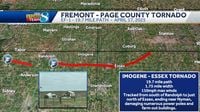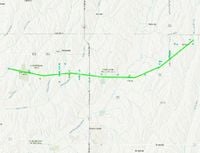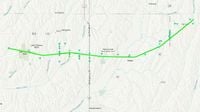CEDAR RAPIDS, Iowa — A powerful tornado that swept through parts of Fremont and Page counties on Thursday night, April 17, has been confirmed as the widest tornado on record for Iowa. The National Weather Service (NWS) reported that the EF-1 tornado touched down just southeast of Randolph at approximately 8:32 p.m. and dissipated east of Nyman at approximately 9:08 p.m., traveling on the ground for 19.7 miles.
With wind speeds reaching up to 110 mph, the tornado caused significant damage to numerous power poles and several farm outbuildings. Severe damage was noted to buildings south of Imogene, where the tornado's impact was most concentrated. At its peak, the tornado measured approximately 3,130 yards wide, or about 1.75 miles, making it roughly 500 yards wider than the previous record-holder, a tornado that struck near Pocahontas on April 9, 2011, which was around 1.5 miles wide.
This tornado is not only the widest tornado in Iowa's history but also holds the title for the widest EF-1 tornado ever recorded. Tornadoes exceeding 1.5 miles in width are extremely rare, with only 30 such tornadoes documented across the United States.
According to the Omaha NWS storm survey, the first sign of damage was snapped tree limbs near Lake Shawtee Wildlife Management Area. As the tornado progressed eastward, it caused extensive tree damage along with the destruction of small outdoor farm buildings and house roofs. In the area south of Imogene, the damage included snapped wooden power poles, minor damage to homes, and the continued destruction of outdoor buildings and trees.
The tornado tracked just north of Essex, where additional damage was reported, including more snapped wooden power poles and farm building damage. After passing north of Essex, the tornado continued northeast towards Nyman, where similar damage was observed along its path. The tornado lifted just east of Nyman at approximately 9:08 PM CDT.
Residents in the affected areas were left to assess the damage and begin recovery efforts following the storm. Local authorities and emergency services responded promptly, working to restore power and clear debris from the roads. The NWS continues to monitor the situation and provide updates as needed.
The Enhanced Fujita Scale classifies tornadoes based on their wind speeds and the resulting damage. An EF-1 tornado, such as the one that struck Iowa, has wind speeds of 86 to 110 mph. The tornado's classification reflects its potential for destruction, particularly in rural areas where structures may be less fortified.
Despite the devastation, no serious injuries or fatalities have been reported, which is a relief to both local officials and residents. The community is now focused on recovery and rebuilding, with many expressing gratitude for the swift response from emergency services.
This tornado serves as a reminder of the power of nature and the importance of preparedness in the face of severe weather events. As climate patterns continue to shift, officials warn that such extreme weather phenomena may become more frequent.
In the days following the tornado, residents are encouraged to report any damage to local authorities and to stay informed about safety measures during severe weather. The NWS continues to emphasize the need for vigilance as the spring storm season progresses.
As the recovery efforts unfold, local businesses and organizations are stepping up to provide support for those affected by the tornado. Fundraising efforts and community outreach programs are being organized to help families rebuild their lives after the storm.
Looking ahead, meteorologists are urging residents to stay aware of weather alerts and to have a plan in place for future severe weather events. Preparedness can save lives and minimize property damage when disaster strikes.
In summary, the April 17 tornado in Iowa not only set a record for width but also highlighted the resilience of the local community in the face of adversity. With recovery efforts underway, residents are coming together to support one another as they navigate the challenges ahead.






